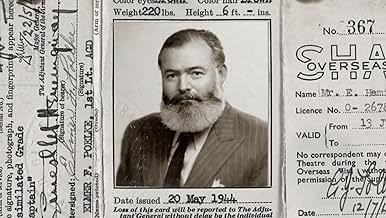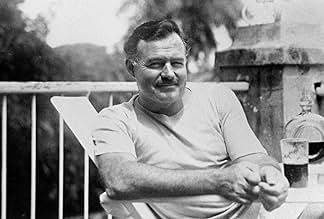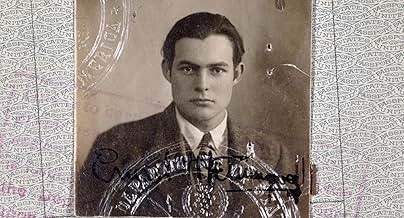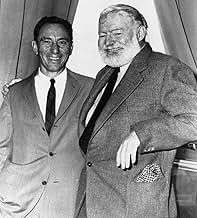Ernest Hemingway(1899-1961)
- Writer
- Actor
Ernest Hemingway was an American writer who won the Pulitzer Prize
(1953) and the Nobel Prize in Literature (1954) for his novel The Old
Man and the Sea, which was made into a 1958 film
The Old Man and the Sea (1958).
He was born into the hands of his physician father. He was the second of six children of Dr. Clarence Hemingway and Grace Hemingway (the daughter of English immigrants). His father's interests in history and literature, as well as his outdoorsy hobbies (fishing and hunting), became a lifestyle for Ernest. His mother was a domineering type who wanted a daughter, not a son, and dressed Ernest as a girl and called him Ernestine. She also had a habit of abusing his quiet father, who suffered from diabetes, and Dr. Hemingway eventually committed suicide. Ernest later described the community in his hometown as one having "wide lawns and narrow minds".
In 1916 Hemingway graduated from high school and began his writing career as a reporter for The Kansas City Star. There he adopted his minimalist style by following the Star's style guide: "Use short sentences. Use short first paragraphs. Use vigorous English. Be positive, not negative." Six months later he joined the Ambulance Corps in WWI and worked as an ambulance driver on the Italian front, picking up human remains. In July 1918 he was seriously wounded by a mortar shell, which left shrapnel in both of his legs causing him much pain and requiring several surgeries. He was awarded the Silver Medal. Back in America, he continued his writing career working for Toronto Star . At that time he met Hadley Richardson and the two married in 1921.
In 1921, he became a Toronto Star reporter in Paris. There he published his first books, called "Three Stories and Ten Poems" (1923), and "In Our Time" (1924). In Paris he met Gertrude Stein, who introduced him to the circle that she called the "Lost Generation". F. Scott Fitzgerald, Thornton Wilder, Sherwood Anderson and Ezra Pound were stimulating Hemingway's talent. At that time he wrote "The Sun Also Rises" (1926), "A Farewell to Arms" (1929), and a dazzling collection of Forty-Nine stories. Hemingway also regarded the Russian writers Lev Tolstoy, Fyodor Dostoevsky, Ivan Turgenev and Anton Chekhov as important influences, and met Pablo Picasso and other artists through Gertrude Stein. "A Moveable Feast" (1964) is his classic memoir of Paris after WWI.
Hemingway participated in the Spanish Civil War and took part in the D-Day landings during the invasion of France during World War II, in which he not only reported the action but took part in it. In one instance he threw three hand grenades into a bunker, killing several SS officers. He was decorated with the Bronze Star for his action. His military experiences were emulated in "For Whom the Bell Tolls" (1940) and in several other stories. He settled near Havana, Cuba, where he wrote his best known work, "The Old Man and the Sea" (1953), for which he won a Pulitzer Prize and the Nobel Prize in Literature. This was adapted as the film The Old Man and the Sea (1958), for which Spencer Tracy was nominated for an Academy Award as Best Actor, and Dimitri Tiomkin received an Oscar for Best Musical Score.
War wounds, two plane crashes, four marriages and several affairs took their toll on Hemingway's hereditary predispositions and contributed to his declining health. He was diagnosed with bipolar disorder and insomnia in his later years. His mental condition was exacerbated by chronic alcoholism, diabetes and liver failure. After an unsuccessful treatment with electro-convulsive therapy, he suffered severe amnesia and his physical condition worsened. The memory loss obstructed his writing and everyday life. He committed suicide in 1961. Posthumous publications revealed a considerable body of his hidden writings, that was edited by his fourth wife, Mary, and also by his son Patrick Hemingway.
He was born into the hands of his physician father. He was the second of six children of Dr. Clarence Hemingway and Grace Hemingway (the daughter of English immigrants). His father's interests in history and literature, as well as his outdoorsy hobbies (fishing and hunting), became a lifestyle for Ernest. His mother was a domineering type who wanted a daughter, not a son, and dressed Ernest as a girl and called him Ernestine. She also had a habit of abusing his quiet father, who suffered from diabetes, and Dr. Hemingway eventually committed suicide. Ernest later described the community in his hometown as one having "wide lawns and narrow minds".
In 1916 Hemingway graduated from high school and began his writing career as a reporter for The Kansas City Star. There he adopted his minimalist style by following the Star's style guide: "Use short sentences. Use short first paragraphs. Use vigorous English. Be positive, not negative." Six months later he joined the Ambulance Corps in WWI and worked as an ambulance driver on the Italian front, picking up human remains. In July 1918 he was seriously wounded by a mortar shell, which left shrapnel in both of his legs causing him much pain and requiring several surgeries. He was awarded the Silver Medal. Back in America, he continued his writing career working for Toronto Star . At that time he met Hadley Richardson and the two married in 1921.
In 1921, he became a Toronto Star reporter in Paris. There he published his first books, called "Three Stories and Ten Poems" (1923), and "In Our Time" (1924). In Paris he met Gertrude Stein, who introduced him to the circle that she called the "Lost Generation". F. Scott Fitzgerald, Thornton Wilder, Sherwood Anderson and Ezra Pound were stimulating Hemingway's talent. At that time he wrote "The Sun Also Rises" (1926), "A Farewell to Arms" (1929), and a dazzling collection of Forty-Nine stories. Hemingway also regarded the Russian writers Lev Tolstoy, Fyodor Dostoevsky, Ivan Turgenev and Anton Chekhov as important influences, and met Pablo Picasso and other artists through Gertrude Stein. "A Moveable Feast" (1964) is his classic memoir of Paris after WWI.
Hemingway participated in the Spanish Civil War and took part in the D-Day landings during the invasion of France during World War II, in which he not only reported the action but took part in it. In one instance he threw three hand grenades into a bunker, killing several SS officers. He was decorated with the Bronze Star for his action. His military experiences were emulated in "For Whom the Bell Tolls" (1940) and in several other stories. He settled near Havana, Cuba, where he wrote his best known work, "The Old Man and the Sea" (1953), for which he won a Pulitzer Prize and the Nobel Prize in Literature. This was adapted as the film The Old Man and the Sea (1958), for which Spencer Tracy was nominated for an Academy Award as Best Actor, and Dimitri Tiomkin received an Oscar for Best Musical Score.
War wounds, two plane crashes, four marriages and several affairs took their toll on Hemingway's hereditary predispositions and contributed to his declining health. He was diagnosed with bipolar disorder and insomnia in his later years. His mental condition was exacerbated by chronic alcoholism, diabetes and liver failure. After an unsuccessful treatment with electro-convulsive therapy, he suffered severe amnesia and his physical condition worsened. The memory loss obstructed his writing and everyday life. He committed suicide in 1961. Posthumous publications revealed a considerable body of his hidden writings, that was edited by his fourth wife, Mary, and also by his son Patrick Hemingway.



























